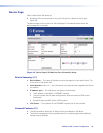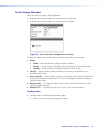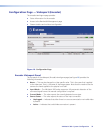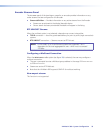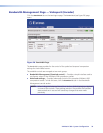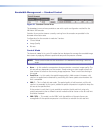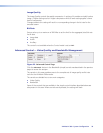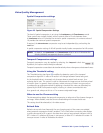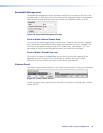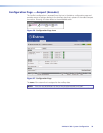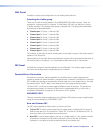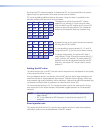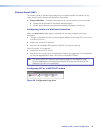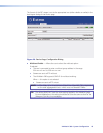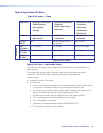
VN-Matrix 300 • System Conguration 37
Video Quality Management
Spatial Compression settings
Figure 23. Spatial Compression Settings
The level of spatial compression is set using the Luminance and Chrominance control.
These controls are normally locked, with an optimal offset of 2 units between them.
A Luminance value of 0 provides the minimum spatial compression; a Luminance value of
10 provides the maximum spatial compression.
If required, the Chrominance compression may be set independently by unchecking the
Lock box.
A spatial compression setting of 4/6 will provide visually lossless compression for HD content.
NOTE: By default, the Luminance and Chrominance offset is set to 2 whenever the
simple (standard) management scheme is selected.
Temporal Compression settings
Temporal compression may be applied by selecting the Temporal check box.
By default, this option should always be selected.
Temporal compression causes data to be transferred only when a change occurs between frames.
Using the Threshold setting
The Threshold setting (see figure 23) modifies the detection point of the temporal
compression algorithm. A value of 0 results in all changes between frames being sent.
As the threshold value is increased, only changes above a certain level are sent, thus
reducing the bit rate. This control is used to compensate for image sources that have a level
of noise in them. In general, there is always a certain amount of noise in any source that
is produced by an analogue method. By applying a threshold this noise can effectively be
ignored by the PURE3 compression engine, resulting in a lower transmitted bit rate.
As a general rule, always set this to a 1 for a camera originated image.
When to use the Chroma setting
The Chroma setting adapts the temporal compression to take note of the chroma changes in
an image. When enabled, note that chroma thresholding will increase the bit rate.
This setting should be selected (on) for video sources.
Refresh Rate
Refresh rate controls how frequently the non-changing parts of the screen are updated
when temporal compression mode is enabled. This is useful when connecting new displays
to a Mb source and to fill in gaps in the data when using a lossy network transport such as
RTP. A value of 1 refreshes the screen in one second, a value of 0.1 refreshes the screen 10
times per second. A value of 0 disables the refresh.



